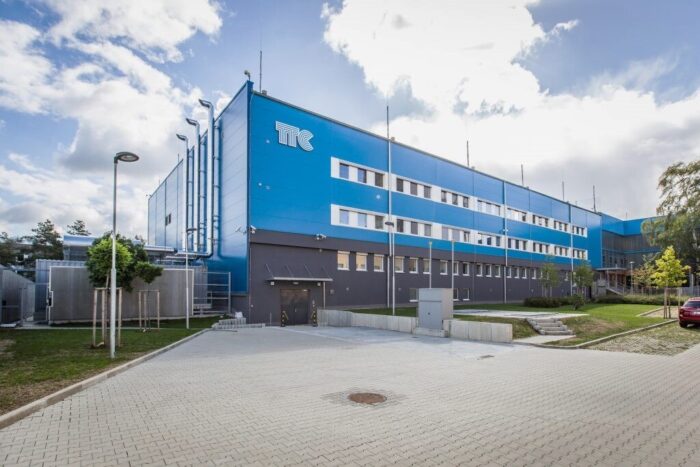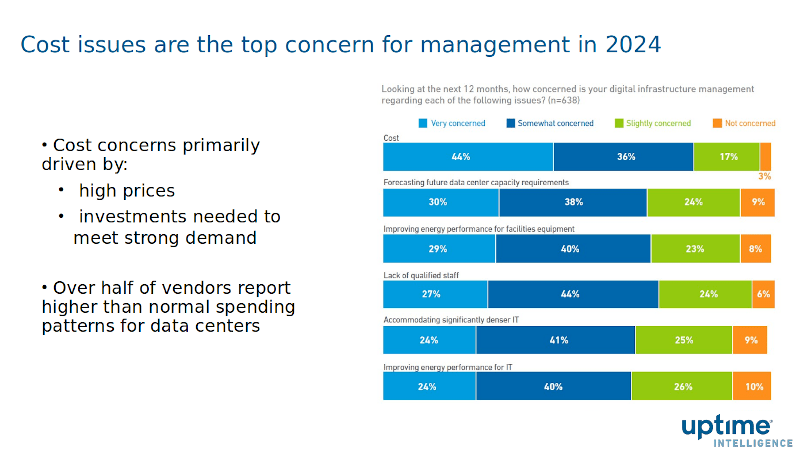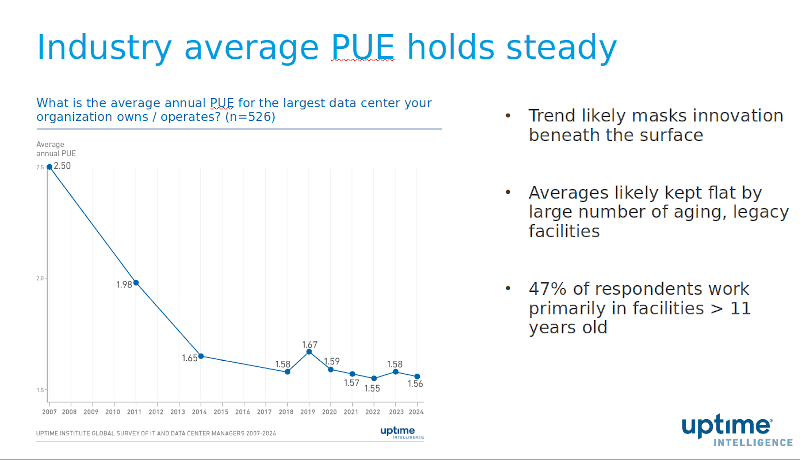When Uptime Institute asked about costs for the first time in this year’s survey, it found them to be the number one concern for data center operators.

One of the things that caught folks by surprise from the results of this year’s Global Data Center Survey was that costs topped the list of things that are concerning data center managers. Surprised, because this was the first year that Uptime Institute, the organization that conducts the survey, specifically asked about costs when asking about data center operators’ concerns, so nobody expected this to end up topping the list, and by a wide margin.
According to Doug Donnellan, an Uptown research analyst, one of the reasons for the surprise was that in the previous year there wasn’t any one particular issue that was clearly out front in the part of the survey that dealt with “concerns.” This year, however, 44% of respondents ticked cost’s “very concerned” box when asked the check-all-that-apply question, “Looking at the next 12 months, how concerned is your digital infrastructure management regarding each of the following issues?” All of the other issues listed were considered very concerning by 30% to 24% of respondents.
“We believe this could have a lot to do with higher prices and also, at the same time, the need to meet very strong and growing demand,” Donnellan said, speaking as the ringleader at an online briefing the company hosted a couple of weeks back to discuss the survey. For this part of the briefing, he was joined by Andy Lawrence, the organization’s executive director of research, and Chris Brown, its chief technical officer.
Uptime Institute is a data center advisory organization that’s probably most well known for developing the tier standard for classifying data centers based on uptime, security, and redundancy. Each year it conducts a Global Data Center Survey that’s intended to be something of a snapshot of the data center industry during the preceding year.
Was Cost Always at the Top of the List and Nobody Knew?
Because Uptime’s Global Data Center Survey has never asked specifically about cost before, it would seem to be a sure bet that how this issue would have fared in earlier surveys is a forever unknown factor. However, for this year’s briefing the issue was treated sort of as if it had gone from being of no concern to being a pressing issue in the course of a single year.
When asked why he thought cost “rose to the top of this list now that we’ve added it this year,” Lawrence immediately pointed to a couple of current usual suspects: the sudden onslaught of inflation and Covid era supply chain issues.

“If you go to some of the industry events and you see the amount of investment going to the sector and the amount of money that’s being spent, you wouldn’t think this is an industry that worries about cost,” he said. “Actually, the cost of building and operating data centers, after actually a fairly sustained period where they were drifting downwards, has gone up in the last several years. This is partly the inflation that’s gone across the world that everyone is familiar with, but it’s also driven by the supply chain issues which followed on from Covid, high energy prices, staff shortages and really the overall really strong demand picture.”
Lawrence also pointed out that concerns around costs can vary according to whether the data center is an enterprise’s on-premises facility of a colocation center data center.
“Enterprises don’t find it necessarily as easy to pass on the costs, and so they’re certainly finding that’s an issue,” he said. “Many of the colos that we talk to are now preparing for higher densities, a new wave of investment, and that’s making them worry about how much they’re spending, because the actual demand and the income that will come from that may be several years out, so I think cost issue is going to be a top concern for a few years.”
Donnellan pointed out that elsewhere in the report more than half of the respondents indicated that the year’s spending was higher than normal. “There is more spending, so cost is somewhat naturally going to be a big concern,” he said.
The unknown additional costs that AI might bring to the table are also a concern, he added.
PUE and Data Center Costs
The somewhat good news on the data center cost front is that power usage effectiveness has been relatively flat for a while now, although many have been expecting that costs associated with PUE will start declining as older less efficient equipment is retired and replaced with more efficient technology.
Chris Brown doesn’t think that’s likely to happen in the near future, however.

“The reason is that efficiency is not the only driving factor in data center design and operations,” he explained. “The other thing that’s competing for attention is availability. Availability is job one in a data center, and so data center operators are balancing, or constantly trying to balance, the need for ever increasing efficiency with maintaining availability levels wherever their business need requires it to.”
To illustrate a way that availability can get in the way of efficiency, he pointed out that increasing a server’s inlet temperatures would increase efficiency but would negatively impact availability in a couple of ways, with the first being the time to a hardware failure.
“The time duration between having an equipment issue, a cooling issue, and actually impacting IT operations is much shorter the higher you run those server inlet temperatures,” he explained.
In addition, Brown pointed out that running equipment at higher temperatures could in come cases have a negative effect on warranty protection.
“Instead of solving for the maximum efficiency that we can get out of a data center, we have to solve for a coincident maximum between availability and efficiency,” he added. “So I think with that reality, we’re not going to see PUE meaningfully decrease significantly over the next few years.”
PUE is also affected by geography — specifically by climate — Lawrence pointed out, which affects PUEs in emerging markets.
“One of the things that’s kind of obvious, a lot of the newer countries, the less mature markets, operate in higher temperatures and higher humidity than a lot of the original North America and European data centers in more temperate zones, where it’s possible to achieve lower PUEs,” he said.
Tomorrow: How server rack density is affecting the data center.
Christine Hall has been a journalist since 1971. In 2001, she began writing a weekly consumer computer column and started covering Linux and FOSS in 2002 after making the switch to GNU/Linux. Follow her on Twitter: @BrideOfLinux





The sudden sudden 3-10x increases in costs from VMWare by Broadcom is probably is probably at least partly what move cost to a top concern.